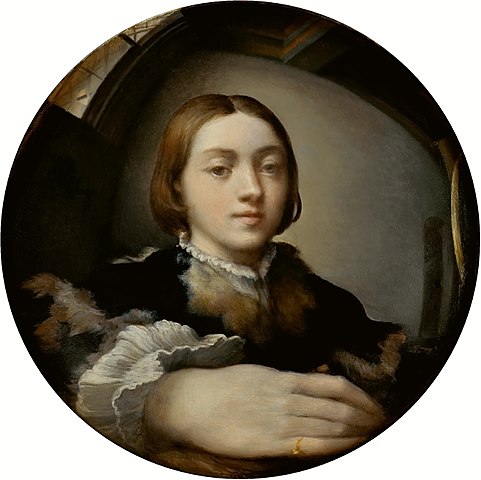
Born: 11 January 1503, Parma
Died: 24 August 1540 (aged 37)
Period: Mannerism
The Life of Parmigianino
Girolamo Francesco Maria Mazzola, better known as Parmigianino (1503–1540), was an Italian Mannerist painter and printmaker active during the Renaissance. Born in Parma, Italy, Parmigianino is celebrated for his elongated figures, sophisticated use of perspective, and the ethereal quality of his works, which marked a distinct evolution from the High Renaissance to the Mannerist style.
Early Life and Training Parmigianino was born into a family of painters, which provided his initial training ground in art. His early talent was evident, and by the age of 16, he had already produced significant works. His early exposure to the works of Correggio, a leading painter of the time, had a profound influence on his developing style, characterized by softness and grace.
Career Development In 1524, Parmigianino went to Rome, hoping to find patronage under Pope Clement VII. His arrival coincided with a period of great artistic fervor in the city, and he was quickly absorbed into the artistic community. The Sack of Rome in 1527 forced him to leave the city, but this period was crucial for his artistic development. His works from this time reflect a mastery of drawing and an innovative use of perspective and proportion.
Mannerist Style Parmigianino’s style is distinguished by its refinement, the elegance of his figures, and a penchant for unconventional poses and proportions that became hallmarks of Mannerism. His most famous painting, “Madonna with the Long Neck” (1534–1540), exemplifies these characteristics with its exaggerated proportions and sophisticated composition.
Later Years After leaving Rome, Parmigianino returned to Parma and later moved to Bologna. Despite his talents, his later years were marked by financial difficulties and a growing eccentricity. His focus turned increasingly towards alchemy, which consumed much of his time and resources. He was eventually imprisoned for failing to complete a commission for the church of Santa Maria della Steccata in Parma.
Death and Legacy Parmigianino died in 1540 at the age of 37 in Casalmaggiore, near Parma. Despite his relatively short life and career, Parmigianino left a significant impact on the art world. His innovative techniques, particularly in printmaking, and his distinctive Mannerist style influenced many subsequent artists. Today, Parmigianino is remembered as one of the early pioneers of Mannerism, and his works are celebrated for their beauty, sophistication, and technical mastery.
Parmigianino’s Notable Works
Parmigianino, known for his significant contributions to the Mannerist style of the Italian Renaissance, created works celebrated for their elegance, elongated forms, and innovative compositions. Here are ten of his most famous works, which highlight his mastery and influence:
- “Madonna with the Long Neck” (1534-1540) – Housed in the Uffizi Gallery, Florence, this painting is emblematic of Mannerism with its unusual proportions and sophisticated grace, depicting the Virgin Mary with an elongated neck cradling the Christ child.
- “Self-Portrait in a Convex Mirror” (c. 1524) – A remarkable self-portrait that showcases Parmigianino’s skill in using a convex mirror to create a distorted perspective, demonstrating his interest in experimentation and optical effects.
- “The Vision of St. Jerome” (1527) – This painting, also known as “St. Jerome and the Angel,” features the saint in a dynamic, twisted pose, reflecting Parmigianino’s talent for conveying movement and emotion.
- “Antea” (c. 1531-1534) – A portrait of a noblewoman, celebrated for its exquisite detail, elegance, and the mysterious air surrounding the subject’s identity, showcasing Parmigianino’s prowess in portraiture.
- “Cupid Carving His Bow” (c. 1533-1535) – A captivating depiction of Cupid, notable for its delicate rendering and the sensual portrayal of the figure, highlighting Parmigianino’s skill in depicting mythological subjects.
- “The Mystical Marriage of Saint Catherine” (c. 1527) – This painting, showcasing St. Catherine of Alexandria in a mystical marriage with the Christ child, is admired for its graceful figures and refined composition.
- “Conversion of St. Paul” (1527) – A dynamic composition that captures the dramatic moment of St. Paul’s conversion on the road to Damascus, illustrating Parmigianino’s ability to convey narrative through art.
- “Portrait of Galeazzo Sanvitale” (1524) – Housed in the Capodimonte Museum, Naples, this portrait is noted for its detailed realism and the sophisticated depiction of the subject’s character, demonstrating the artist’s skill in capturing the essence of his sitters.
- “Madonna of the Rose” (c. 1520-1522) – An early work that depicts the Virgin Mary and Christ child with a flowering rose, symbolizing the mystery of the Incarnation, showcasing Parmigianino’s early development of his characteristic style.
- “The Circumcision of Jesus” (1523) – Located in the Detroit Institute of Arts, this painting is notable for its detailed portrayal of a biblical scene, set against a rich architectural background, reflecting Parmigianino’s interest in religious subjects.
Parmigianino’s works continue to be celebrated for their innovative approach to composition, form, and perspective, marking him as a key figure in the transition from the High Renaissance to Mannerism.